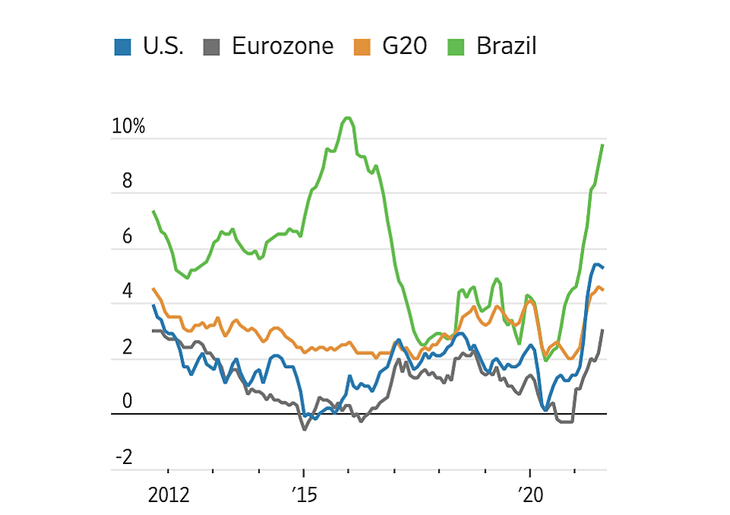(VOVWORLD) - Despite the severe impacts of the COVID-19 pandemic, the global economy in 2021 has avoided a recession and has rapidly rebounded to resume its growth. However, the emergence of new coronavirus variants like Delta and Omicron and consequences of the pandemic like supply chain disruptions and inflation are keeping the global economic recovery unstable and inconsistent.
 Annual inflation rate of the United States (blue), Europezone (gray), the G20 (orange) and Brazil (green). Photo: WSJ Annual inflation rate of the United States (blue), Europezone (gray), the G20 (orange) and Brazil (green). Photo: WSJ |
In the World Economic Outlook released at the autumn summit of the IMF and the WB in October, the International Monetary Fund (IMF) lowered its global growth projection for 2021 to 5.9 percent. Although that’s 0.1 percent lower than the July forecast, 5.9% growth is encouraging compared to the -4.4% growth in 2020.
Positive changes
The biggest boost for the global economy in 2021 came in the first months of the year when many countries resumed almost all economic activities under a new pandemic strategy of flexible adaptation with high vaccination coverage.
IHS Market, a global company that collects data for the Purchasing Managers’ Index, said global GDP in the second quarter of 2021 surpassed the 4th quarter of 2019, just before the pandemic began. In the July World Economic Outlook both the IMF and the WB said the global economy will recover at the fastest post-recession pace in 80 years, largely on strong rebounds by a few major economies like the US, China, and the EU.
Combining two huge economic stimulus packages with a rapid vaccination program, the world's number one economy, the US, bounced back strongly, achieving in the second quarter of this year the fastest quarterly GDP growth in the last 70 years.
The Organization for Economic Cooperation and Development (OECD) said the US could grow 6% this year. EU countries may grow more than the 5% that was forecast.
Similarly, China has seen steady growth in 2021 and its GDP growth is now expected to exceed the target of 6%. The OECD predicts that China’s GDP will grow 8.5%.
Although recovery momentum shows signs of slowing down as new pandemic waves force many countries to delay their reopening plans, there is reason for optimism. In addition to global GDP growth of nearly 6%, according to the IMF forecast, the World Trade Organization predicts global trade to grow 10.7%, in contrast to an 8% decline last year.
Challenges and prospects
With supply chain disruptions, high inflation, and the emergence of new variants of the Sars-CoV-2 virus, like the Omicron variant that appeared late this year, the global economic recovery is still a work in progress.
For one thing, recovery and growth is not equal for all countries and regions. Bruce Kasman, chief economist for JPMorgan Bank, said the imbalance is unprecedentedly high. Reports from global organizations say the main cause is unequal vaccination coverage. Our World in Data reported that as of December 55% of the global population had received at least 1 vaccine dose. But the rate in low-income countries is just 6.2%, which could lead to new pandemic waves.
High inflation is another serious threat to the global economy. In a statement on December 6, IMF Director General Kristalina Georgieva said the global economy continues to recover, but faces many risks, including the evolution of COVID-19 and growing inflation.
Global financial institutions believe the global economy will prosper in 2022. Marko Kolanovic, head of global market strategists at JPMorgan, said 2022 will be a year of global recovery, the COVID-19 pandemic will be contained, and economies will flexibly adapt to the situation.
In an annual report published on Sunday, the UK Center for Economic and Business Research said that despite the impacts of COVID-19, global GDP in 2022 will be higher than before the pandemic, and could reach 100 trillion USD for the first time.